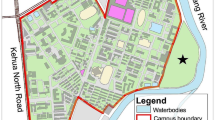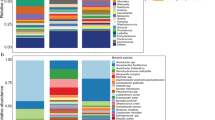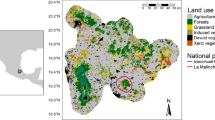Abstract
We studied the parasitoid complex of Bactrocera oleae Rossi (Diptera: Tephritidae) in order to analyse the parasitism response to landscape structure at different spatial extents. Olive fruits were sampled and incubated in the laboratory for insect emergence, thus allowing the calculation of parasitoid emergence rates. A landscape analysis was performed in five concentric buffers, ranging from 0.5 to 2 km diameter around the sampling points. Woodland was chosen as focal class. The percentage of landscape and the splitting index, a measure of fragmentation, were used to quantify landscape composition and configuration, respectively. Significant effects of landscape on parasitism rates were detected. In particular, the percent parasitoid emergence was negatively affected by the splitting index of woodland at a spatial extent ranging from 1 to 2 km. These findings suggest that landscape characteristics are likely to affect parasitoids in well-structured agroecosystems as well. In particular, connectivity at a large scale may favour B. oleae parasitoids more than the abundance of woodland. Potential implications for conservation biological control are discussed.



Similar content being viewed by others

References
Altieri MA, Nicholls CI (2001) Biodiversity and pest management in agroecosystems. Food Products Press, New York
Altobelli A, Bressan E, Feoli E, Ganis P, Martini F (2006) Digital representation of spatial variation of multivariate landscape data. Community Ecol 7:181–188
Anton C, Zeisset I, Musche M, Durka W, Boomsma JJ, Settele J (2007) Population structure of a large blue butterfly and its specialist parasitoid in a fragmented landscape. Mol Ecol 16:3828–3838
Arambourg Y (1986) Entomologie oléicole. Conseil Oleicole International, Madrid
Bailey D, Billeter R, Aviron S, Schweiger O, Herzog F (2007) The influence of thematic resolution on metric selection for biodiversity monitoring in agricultural landscapes. Landscape Ecol 22:461–473
Bianchi FJJA, van Wingerden WKRE, Grioffioen AJ, van der Veen M, van der Straten MJJ, Wegman RMA, Meeuwsen HAM (2005) Landscape factors affecting the control of Mamestra brassicae by natural enemies in Brussels sprouts. Agric Ecosyst Environ 107:145–150
Botequila Leitão A, Miller J, Ahern J, McGarigal K (2006) Measuring landscapes, a professional planner’s manual. Island Press, Washington, DC
Broumas T, Haniotakis G, Liaropoulos C, Tomazou T, Ragoussis N (2002) The efficacy of an improved form of the mass-trapping method, for the control of the olive fruit fly, Bactrocera oleae (Gmelin) (Dipt., Tephritidae): pilot-scale feasibility studies. J Appl Entomol 126:217–223
Burel F, Baudry J, Butet A, Clergeau P, Delettre Y, Le Coeur D, Dubs F, Morvan N, Paillat G, Petit S, Thenail C, Brunel E, Lefeuvre J-C (1998) Comparative biodiversity along a gradient of agricultural landscapes. Acta Oecol 19:47–60
Chust G, Pretus JL, Ducrot D, Bedòs A, Deharveng L (2003) Identification of landscape units from an insect perspective. Ecography 26:257–268
Chust G, Pretus JL, Ducrot D, Ventura D (2004) Scale dependency of insect assemblages in response to landscape pattern. Landscape Ecol 19:41–57
Chust G, Garbin L, Pujade-Villar J (2007) Gall wasps and their parasitoids in cork oak fragmented forests. Ecol Entomol 32:82–91
Clough Y, Kruess A, Kleijn D, Tscharntke T (2005) Spider diversity in cereal fields: comparing factors at local, landscape and regional scales. J Biogeogr 32:2007–2014
Collier TR, Van Steenwyk RA (2003) Prospects for integrated control of olive fruit fly are promising in California. Calif Agric 57:28–31
Cronin JT (2003) Matrix heterogeneity and host-parasitoid interactions in space. Ecology 84:1506–1516
Dauber J, Hirsch M, Simmering D, Waldhardt R, Otte A, Wolters V (2003) Landscape structure as an indicator of biodiversity: matrix effects on species richness. Agric Ecosyst Environ 98:321–329
Debras J-F, Torre F, Rieux R, Kreiter S, Garcin MS, van Helden M, Buisson E, Dutoit T (2006) Discrimination between agricultural management and the hedge effect in pear orchards (south-eastern France). Ann Appl Biol 149:347–355
Dormann CF, Schweiger O, Augenstein I, Bailey D, Billeter R, De Blust G, DeFilippi R, Frenzel M, Hendrickx F, Herzog F, Klotz S, Liira J, Maelfait J-P, Schmidt T, Speelmans M, van Wingerden WKRE, Zobel M (2007) Effects of landscape structure and land-use intensity on similarity of plant and animal communities. Glob Ecol Biogeogr 16:774–787
Elziga JA, Van Nouhuys S, van Leeuwen D-J, Biere A (2007) Distribution and colonization ability of three parasitoids and their herbivorous host in a fragmented landscape. Basic Appl Ecol 8:75–88
ESRI (2003) ArcGIS 8. Environmental Systems Research Institute, Redlands, CA
Farina A (2006) Principles and methods in landscape ecology. Springer, New York
Forman RTT, Godron M (1986) Landscape ecology. Wiley, New York
Gaucherel C, Burel F, Baudry J (2007) Multiscale and surface pattern analysis of the effect of landscape pattern on carabid distribution. Ecol Indic 7:598–604
Harrison S, Bruna E (1999) Habitat fragmentation and large-scale conservation: what do we know for sure? Ecography 22:225–232
Jackson LE, Hilborn ED, Thomas JC (2006) Towards landscape design guidelines for reducing Lyme disease risk. Int J Epidemiol 35:315–322
Jackson LE, Pascual U, Hodgkin T (2007) Utilizing and conserving agrobiodiversity in agricultural landscapes. Agric Ecosyst Environ 121:196–210
Jaeger JAG (2000) Landscape division, splitting index, and effective mesh size: new measures of landscape fragmentation. Landscape Ecol 15:115–130
Keyghobadi N, Roland J, Strobeck C (2005) Genetic differentiation and gene flow among populations of the alpine butterfly, Parnassius smintheus, vary with landscape connectivity. Mol Ecol 14:1897–1909
Kruess A (2003) Effects of landscape structure and habitat type on a plant-herbivore-parasitoid community. Ecography 26:283–290
Lee JC, Heimpel GE, Leibee GL (2004) Comparing floral nectar and aphid honeydew diets on the longevity and nutrient levels of a parasitoid wasp. Entomol Exp Appl 111:189–199
McGarigal K, Cushman SA, Neel MC, Ene E (2002) FRAGSTATS: spatial pattern analysis program for categorical maps. Computer software program produced by the authors at the University of Massachusetts, Amherst. Available via DIALOG. www.umass.edu/landeco/research/fragstats/fragstats.html. Accessed 20 Feb 2008
Moran MD (2003) Arguments for rejecting the sequential Bonferroni in ecological studies. Oikos 100:403–405
Nardi F, Carapelli A, Dallai R, Roderick GK, Frati F (2005) Population structure and colonization history of the olive fly, Bactrocera oleae (Diptera, Tephritidae). Mol Ecol 14:2729–2738
Neuenschwander P, Bigler F, Delucchi V, Michelakis S (1983) Natural enemies of preimaginal stages of Dacus oleae Gmel. (Dipt., Tephritidae) in Western Crete. I. Bionomics and phenologies. Bollettino del Laboratorio di Entomologia Agraria “Filippo Silvestri”. Portici 40:3–32
Öckinger E, Smith HG (2007) Semi-natural grasslands as population sources for pollinating insects in agricultural landscapes. J Appl Ecol 44:50–59
Östman Ö, Ekbom B, Bengtsson J (2001) Landscape heterogeneity and farming practice influence biological control. Basic Appl Ecol 2:365–371
Ovruski SM, Schliserman P, Aluja M (2004) Indigenous parasitoids (Hymenoptera) attacking Anastrepha fraterculus and Ceratitis capitata (Diptera: Tephritidae) in native and exotic host plants in Northwestern Argentina. Biol Control 29:43–57
Pascual U, Perrings C (2007) Developing incentives and economic mechanisms for in situ biodiversity conservation in agricultural landscapes. Agric Ecosyst Environ 121:256–268
Petacchi R, Rizzi I, Guidotti D (2003) The “lure and kill” technique in Bactrocera oleae (Gmel.) control: effectiveness indices and suitability of the technique in area-wide experimental trials. Int J Pest Manag 49:305–311
Purtauf T, Roschewitz I, Dauber J, Thies C, Tscharntke T, Wolters V (2005) Landscape context of organic and conventional farms: influences on carabid beetle diversity. Agric Ecosyst Environ 108:165–174
Radford JQ, Bennett AF, Cheers GJ (2005) Landscape-level thresholds of habitat cover for woodland dependent birds. Biol Conserv 124:317–337
Rand TA, Tscharntke T (2007) Contrasting effects of natural habitat loss on generalist and specialist aphid natural enemies. Oikos 116:1353–1362
Roschewitz I, Hücker M, Tscharntke T, Thies C (2005) The influence of landscape context and farming practices on parasitism of cereal aphids. Agric Ecosyst Environ 108:218–227
Russo L (1967) Study on the hymenopterous parasites of the olive fly (Dacus oleae Gmel.) in Campania [in Italian]. Bollettino del Laboratorio di Entomologia Agraria “Filippo Silvestri”. Portici 25:177–228
Sánchez-Zapata JA, Calvo JF (1999) Raptor distribution in relation to landscape composition in semi-arid Mediterranean habitats. J Appl Ecol 36:254–262
Santos SAP, Pereira JA, Torres LM, Nogueira AJA (2006) Evaluation of the effects, on canopy arthropods, of two agricultural management systems to control pests in olive groves from north–east of Portugal. Chemosphere 67:131–139
Saour G, Makee H (2004) A kaolin-based particle film for suppression of the olive fruit fly Bactrocera oleae Gmelin (Dip., Tephritidae) in olive groves. J Appl Entomol 128:28–31
Schmidt MH, Roschewitz I, Thies C, Tscharntke T (2005) Differential effects of landscape and management on diversity and density of ground-dwelling farmland spiders. J Appl Ecol 42:281–287
Schweiger O, Maelfait JP, Van Wingerden W, Hendrickx F, Billeter R, Speelmans M, Augenstein I, Aukema B, Aviron S, Bailey D, Bukacek R, Burel F, Diekotter T, Dirksen J, Frenzel M, Herzog F, Liira J, Roubalova M, Bugter R (2005) Quantifying the impact of environmental factors on arthropod communities in agricultural landscapes across organizational levels and spatial scales. J Appl Ecol 42:1129–1139
Shaw MR (2006) Habitat considerations for parasitic wasps (Hymenoptera). J Insect Conserv 10:117–127
Sivinski JM, Calkins CO, Baranowski R, Harris D, Brambila J, Diaz J, Burns RE, Holler T, Dodson G (1996) Suppression of a Caribbean fruit fly (Anastrepha suspensa (Loew) Diptera: Tephritidae) population through augmented releases of the parasitoid Diachasmimorpha longicaudata (Ashmead) (Hymenoptera: Braconidae). Biol Control 6:177–185
Summerville KS, Crist TO (2004) Contrasting effects of habitat quantity and quality on moth communities in fragmented landscapes. Ecography 27:3–12
Thies C, Steffan-Dewenter I, Tscharntke T (2003) Effects of landscape context on herbivory and parasitism at different spatial scales. Oikos 101:18–25
Tscharntke T, Klein AM, Kruess A, Steffan-Dewenter I, Thies C (2005) Landscape perspectives on agricultural intensification and biodiversity-ecosystem service management. Ecol Lett 8:857–874
Tscharntke T, Bommarco R, Clough Y, Crist TO, Kleijn D, Rand TA, Tylianakis JM, van Nouhuys S, Vidal S (2007) Conservation biological control and enemy diversity on a landscape scale. Biol Control 43:294–309
Tylianakis JM, Didham RK, Wratten SD (2004) Improved fitness of aphid parasitoids receiving resource subsidies. Ecology 85:658–666
Warlop F (2006) Limitation des populations de ravageurs de l’olivier par le recours à la lutte biologique par conservation. Cah Agric 15:449–455
Watson JEM, Whittaker RJ, Freudenberger D (2005) Bird community responses to habitat fragmentation: how consistent are they across landscapes? J Biogeogr 32:1353–1370
Weibull A-C, Östman Ö, Granqvist Å (2003) Species richness in agroecosystems: the effect of landscape, habitat and farm management. Biodivers Conserv 12:1335–1355
Winkler K, Wäckers F, Bukovinszkine-Kiss G, van Lenteren J (2006) Sugar resources are vital for Diadegma semiclausum fecundity under field conditions. Basic Appl Ecol 7:133–140
Acknowledgments
We wish to thank the farmers for participating in the project. We are grateful to Gennaro Viggiani for entomological advice, to Diego Guidotti for assistance in GIS work, and to Giovanni Burgio and Paolo Bàrberi for critically reviewing our manuscript. Linda Takahashi improved our English. This study was carried out within the RIOM project, funded by the Ministry of Agriculture.
Author information
Authors and Affiliations
Corresponding author
Additional information
Handling Editor: Torsten Meiners.
Rights and permissions
About this article
Cite this article
Boccaccio, L., Petacchi, R. Landscape effects on the complex of Bactrocera oleae parasitoids and implications for conservation biological control. BioControl 54, 607–616 (2009). https://doi.org/10.1007/s10526-009-9214-0
Received:
Accepted:
Published:
Issue Date:
DOI: https://doi.org/10.1007/s10526-009-9214-0



